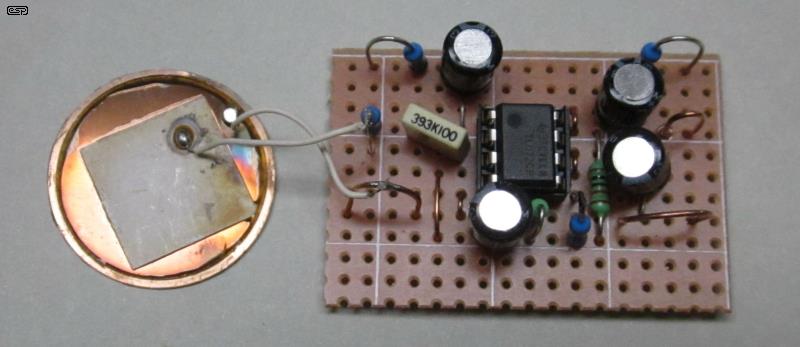

If you parallel the inputs you may need a different value. Mine is chosen purely for the supply through the left hand channel. Your optimal value of R2 may be different due to the spread in FET Vgs- put a multimeter on the drain and aim for about half the open-circuit voltage 3 ☑0%. Time will tell if I get to regret that and the mic goes noisy or fails in service if I drop it once too often. I expect peaks to be lower because I have mechanically damped the mic a lot. I have decided to take a chance with this omitting the diodes of the original FET version, because they’re hard to fit in. Ordinarily you’d bypass R2 with a capacitor to maximise gain, but you are rarely short of signal level with a piezo mic, so I omitted that, it will slightly reduce gain, and also limit the current slightly if the piezo puts too much through the gate/source junction if I drop it. Surprisingly, though they were from Ebay, nominally Fairchild parts, all five I tried biased about right with 470Ω up to 680Ω. I bought a job lot of 2n3819s and experimenting with the value of R2 showed 470Ω put the drain voltage about 1.7V, with the source voltage about 0.5V, dropping about 1.2V across the transistor and 1.3 across the 6k8 drain resistor, which is good enough. That’s fair enough – the IDSS is specified as 2-20mA and the most current you are going to get from a 3V supply through a 6k8 resistor is a little bit shy of 0.5mA. Initially I tried this with R2 omitted (replaced with a short) but there is not enough current to get the drain off the 0V rail.

The basic FET buffer is optimised for 9V, so it won’t run off PiP either. The opamp version will never run on plug in power. That’s not good, and you tie yourself up in wiring. An Olympus LS10 needs two AA cells and will run hours, and then the piezo contact mic wants a box with a 9V battery all to itself. The trouble is that both the FET piezo amplifier and the opamp version need a 9V battery, which is a pain in the backside. there’s not much power available in plug-in-power Ideally a contact mic would work with this just like an electret mic, after all the problem and the solution are the same – a high source impedance 2 requiring a FET to buffer it. You can read more about plug in power here. The 6k8 resistor is the drain resistor of the electret mic. It so happens that electret microphones were coming in at that time, and typically had a FET to buffer the high source impedance of the capacitive electret mic, an audio source through a few tens of pF.
#PIEZO PREAMP SERIES#
Plug in power is about 3-5v supplied through a series 6.8kΩ resistor, with the output developed across the 6.8kΩ resistor. An electret mic doesn’t need much power so battery life is weeks not hours, but it has a switch you often forgot to switch off. to eliminate the battery in the microphone. The recorder generally has to have a battery, and Sony agreed with that many years ago, back in the days of Minidisc, and came up with plug in power (PiP). One battery to rule ’em all is best in my book, the fewer things with a battery required to make a system work the better. You also get an opportunity to drink beer.īatteries are a pain in field recording.
#PIEZO PREAMP PRO#
That is for small recorders like Olympus’s LS10, LS-5, LS14 series, which are typically unbalanced audio inputs, stereo on a 3.5mm jack, not for a P48 phantom power from a mixer or pro recorder 1. This is for a piezo contact mic that is powered off a field recorder’s plug-in-power supply.


 0 kommentar(er)
0 kommentar(er)
